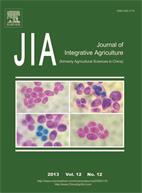|
|
Subsoiling and Ridge Tillage Alleviate the High Temperature Stress in Spring Maize in the North China Plain
TAO Zhi-qiang, SUI Peng, CHEN Yuan-quan, LI Chao, NIE Zi-jin, YUAN Shu-fen, SHI Jiangtao
2013, 12(12):
2179-2188.
DOI: 10.1016/S2095-3119(13)60347-0
High temperature stress (HTS) on spring maize (Zea mays L.) during the filling stage is the key factor that limits the yield increase in the North China Plain (NCP). Subsoiling (SS) and ridge tillage (R) were introduced to enhance the ability of spring maize to resist HTS during the filling stage. The field experiments were conducted during the 2011 and 2012 maize growing seasons at Wuqiao County, Hebei Province, China. Compared with rotary tillage (RT), the net photosynthetic rate, stomatal conductance, transpiration rate, and chlorophyll relative content (SPAD) of maize leaves was increased by 40.0, 42.6, 12.8, and 29.7% under SS, and increased by 20.4, 20.0, 5.4, and 14.2% under R, repectively. However, the treatments reduce the intercellular CO2 concentration under HTS. The SS and R treatments increased the relative water content (RWC) by 11.9 and 6.2%, and the water use efficiency (WUE) by 24.3 and 14.3%, respectively, compared with RT. The SS treatment increased the root length density and soil moisture in the 0-80 cm soil profile, whereas the R treatment increased the root length density and soil moisture in the 0-40 cm soil profile compared with the RT treatment. Compared with 2011, the number of days with temperatures 33°C was more 2 d and the mean day temperature was higher 0.9°C than that in 2012, whereas the plant yield decreased by 2.5, 8.5 and 10.9%, the net photosynthetic rate reduced by 7.5, 10.5 and 18.0%, the RWC reduced by 3.9, 5.6 and 6.2%, and the WUE at leaf level reduced by 1.8, 5.2 and 13.1% in the SS, R and RT treatments, respectively. Both the root length density and the soil moisture also decreased at different levels. The yield, photosynthetic rate, plant water status, root length density, and soil moisture under the SS and R treatments declined less than that under the RT treatment. The results indicated that SS and R can enhance the HTS resistance of spring maize during the filling stage, and led to higher yield by directly improving soil moisture and root growth and indirectly improving plant water status, photosynthesis and grain filling. The study can provide a theoretical basis for improving yield of maize by adjusting soil tillage in the NCP.
|
